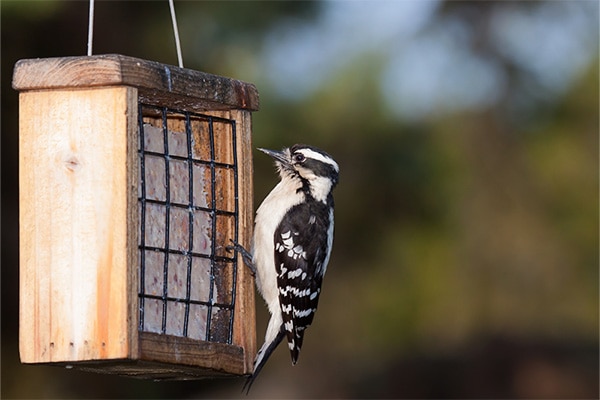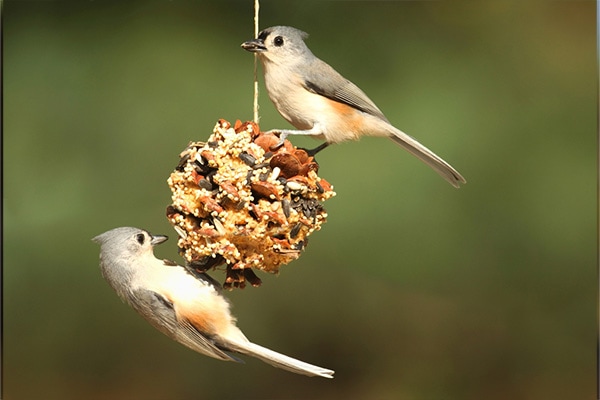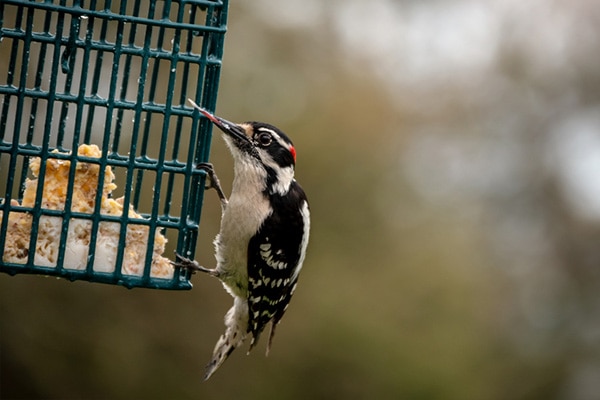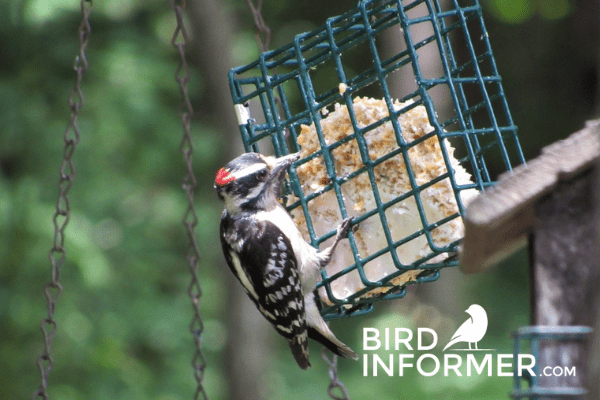Suet cakes are essential to have in bird feeders. It may not be your first bird food choice to serve, but once winter comes, suet is probably one of the things that will provide birds with their needed energy. We’re here to help you learn how to squirrel-proof suet feeders.
Unfortunately, birds are not the only animals that suet attracts; it attracts squirrels, too. Fortunately, there are many ways you can stop squirrels from coming to feeders like:
- Serving only plain suet
- Putting suet in a cage
- Using suet with capsaicin
- Proper placement
- Mounting baffles
This article will talk about how you can squirrel-proof a suet feeder. We’ll also discuss:
- What suet is and why do birds need it
- Squirrel-proofing a suet feeder
- FAQs
So, if you’re interested to know more about how you can squirrel-proof suet feeders, read on…

What Is Suet?
Suet is a mixture of fat taken from around the loins or kidneys of animals and vegetable oils. These fats are mixed and then allowed to solidify and then served to birds in winter.
As suet is purely fat-based, it is very rich in calories, making it an essential food source for birds during extreme weather. It is also sometimes mixed in with seeds and corn for added nutritional sources for birds.
Because of this, even just a small portion of suet is enough to help the birds survive the harsh cold weather. The fat they get from this food source provides them lots of energy to keep themselves warm and healthy until the cold months are over.
There are different types of suet available in the market:
- Pellets
- Blocks
- Balls
- Logs
- Coconuts
- Cakes
- Candles
Each is fed in different ways to birds, but every variety you choose will provide the same benefits.

How To Squirrel-Proof Suet Feeders
Now that we know how vital suet is for birds, let’s discuss how to squirrel-proof suet feeders.
Put Suet Feeder In A Cage
Suet feeders are mostly made out of cages. However, these cages usually have large grids that still allow squirrels to access the suet inside.
So, if you wish to protect the suet feeder, you can put it inside another cage with spaces just big enough for birds to access while keeping squirrels out.
One material you can use is a small grid hardware cloth. Simply fold the item in a shape similar to the suet feeder, but make it a little bigger. Place the suet feeder inside, and you already have dual protection for the suet inside the feeder.
This technique can be very effective. The only problem is that probably bigger birds like woodpeckers won’t get access to it.
Now, if caging the suet feeder is not for you as it prevents you from feeding larger birds, you can do the other techniques below.
Squirrel-Proof Suet By Only Serving Plain Suet
Squirrels don’t particularly like suet.
As mentioned above, suet is mainly just hard fat from animals or vegetables. It doesn’t bring any benefits to them, just like with birds.
So, why do they keep on invading suet feeders?
Well, squirrels are mainly attracted to what’s mixed into a suet cake. This may include seeds, nuts, corn, fruits, or even bugs. These are what the squirrels are after. So, if you serve them just plain suet without any of these things, you might be able to drive the squirrels away.

Serve Suet with Capsaicin
Capsaicin is the compound responsible for the spicy flavor. And while mammals, like squirrels, are affected by spice, birds are not.
So, another way to squirrel-proof suet feeders is by adding a mix of some hot peppers to your suet mixture might just probably give squirrels a lesson not to touch suet cakes again.
How To Squirrel-Proof Suet Feeders With Proper Placement
Just like with ordinary bird feeders, it’s helpful to remember the 5-7-9 rule – numbers that serve as reminders that squirrels can’t:
- Jump more than five feet from the ground
- Jump more than seven feet sideways
- Jump more than nine feet from above
With this in mind, you just need to make sure that you place your suet feeder right so that squirrels won’t get any access to it.
How To Squirrel-Proof Suet Feeders With Mount Squirrel Baffles
You can also use baffles to protect your suet feeders.
For suet feeders, platform baffles work the best. These baffles are placed above the suet feeder as they are often hung up in a tree.
When using such baffles, you need to ensure that they are wide enough to cover the surface of the suet feeder. This way, even if squirrels jump down from a tree, they won’t reach the suet feeder.
You can also have a baffle below the suet feeder for extra security. This way, squirrels won’t be able to reach the feeder in whichever direction they come from.
If you want to check out how to squirrel-proof suet feeders like this , watch the video below:
FAQs
Which birds will eat suet?
Suet will help attract many bird species, mainly because it provides birds enough energy to survive through the cold weather. Some species that would eat suet are:
- Woodpeckers
- Nuthatches
- Wrens
- Jays
- Chickadees
- Goldfinches
- Warblers
And a whole lot more!
Let’s just say that it’s a food staple you need to have in the winter season.
Can I make my own suet?
Yes, you can make your own suet.
If you’ve got lots of time on your hands, it’s definitely something to try out. After all, making your own allows you to know what kind of ingredients you’ve mixed up there. This way, you can ensure the birds’ safety.
There are many recipes available, so make sure to check them out.
You should also remember that when making your own suet, you must never add any sugary ingredients to it.
How do I properly store my suet?
If you bought suet in bulk or made a lot of suet, make sure you store them properly.
As much as possible, you should place them in an airtight container and inside the freezer. Frozen suet will remain okay for six months, so making a lot in one go would surely be worth your time. Just make sure that you keep them away from critters.
How frequently should I change the suet?
Fresh suet will have a shelf-life of 5 days. Longer than that, the suet can go spoiled, endangering any bird that eats it. So, make sure you change your suet every 3-5 days to prevent that from happening.
You should also clean up the suet feeder every time you change the food.
Can I serve suet even in summer?
You can, but it’s not recommended.
Remember, this food is made from solidified fat. When exposed to extreme heat the suet will melt.
On top of that, it’s unnecessary to give birds suet in summer. It’s the time of the year when insects are abundant, so they actually have plenty of protein sources that will keep them healthy.
Final Thoughts
Suet is essential to birds, especially in winter. That’s why safeguarding them from annoying squirrels is necessary.
Fortunately, doing so is not that hard to do. You can use similar techniques that you’d use for regular bird feeders, and they’ll work just the same.
If one technique doesn’t work, you can try combining 2-3 squirrel-proofing ideas above. This way, your suet feeder is more secure, protecting the birds’ number one key to survival during winter – THE SUET.

from BirdInformer.com https://ift.tt/izCQNKj

No comments:
Post a Comment